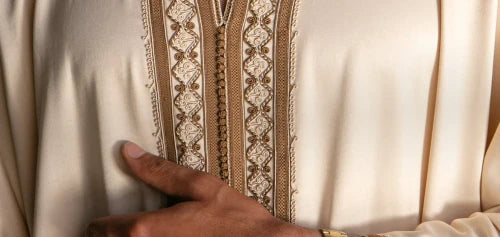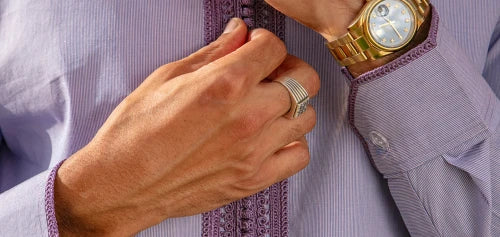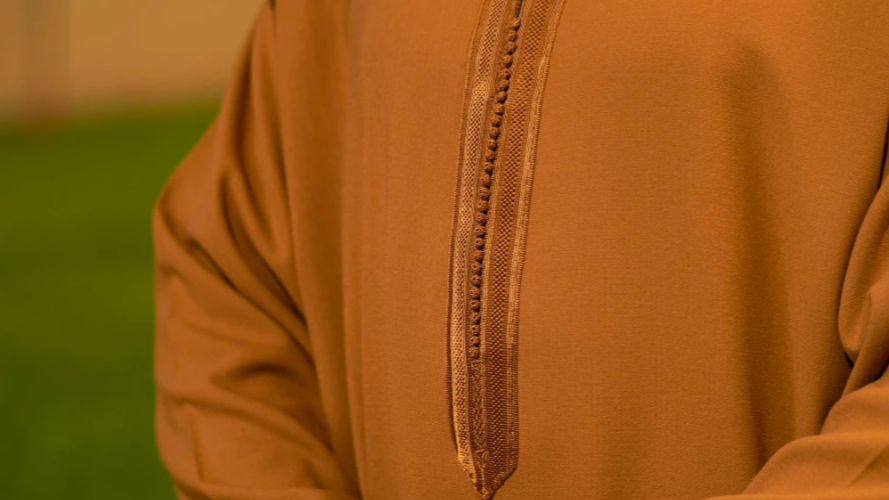The Moroccan djellaba, a garment steeped in history and tradition, is a symbol of Morocco's cultural identity and heritage. This iconic attire, recognized for its elegance and simplicity, has been worn by Moroccans for centuries, transcending time to remain a staple in rural and urban settings. The djellaba is more than just clothing; it represents a way of life, embodying the Moroccan people's values, climate, and artistic sensibilities.
Characterized by its long, loose-fitting design, the djellaba is meticulously crafted to provide comfort and functionality while reflecting the aesthetic beauty of Moroccan craftsmanship. One of its most distinctive features is the pointed hood, known as a "qob," which serves practical purposes such as protection from the sun and sand, indicative of the garment's deep roots in the country's diverse landscapes, from the bustling souks of Marrakech to the serene expanses of the Sahara.
The djellaba's design, while fundamentally traditional, has evolved subtly over time, incorporating various fabrics, colors, and embellishments, showcasing the rich tapestry of Moroccan culture and regional diversity. Each djellaba tells a story; woven into its fabric are the tales of generations, the hands of skilled artisans, and the soul of Moroccan heritage. As we delve into the history of Moroccan djellabas, we uncover not only the evolution of a garment but the enduring spirit of a nation.
Historical Origins and Evolution
The Moroccan djellaba boasts a rich and multifaceted history, tracing its origins back to the early Islamic period. It is believed that the design was influenced by the spiritual and practical needs of the time, providing ample coverage and comfort for both daily activities and religious practices. The djellaba's roots are deeply entwined with the Islamic emphasis on modesty, making it a preferred choice for both men and women in Morocco and across the Maghreb region.
Over the centuries, the djellaba has undergone a subtle yet significant evolution, reflecting changes in societal norms, technological advancements, and cross-cultural influences. During various dynasties that ruled Morocco, such as the Almoravid and Almohad dynasties, the djellaba served as everyday wear and a status symbol, with luxurious fabrics and intricate designs reserved for the elite.
The colonial period introduced new fabrics and patterns, incorporating European influences into traditional Moroccan attire. However, the core design of the djellaba remained intact, a testament to its enduring appeal and functionality. Post-independence, the djellaba experienced a resurgence as a symbol of national identity and pride, with Moroccans embracing their heritage while adapting to modernity.
Today, the djellaba continues to evolve, embracing contemporary fashion trends while remaining true to its historical roots. Designers and artisans experiment with materials, colors, and embellishments, blending tradition with innovation. The djellaba's journey from ancient times to the present day reflects the dynamic nature of Moroccan culture, constantly adapting while preserving its unique identity.
Cultural Significance and Symbolism
The djellaba is not merely a piece of clothing; it is a garment rich with cultural significance and symbolism in Moroccan society. It transcends its practical utility to embody the values, traditions, and social norms of the Moroccan people. The djellaba is a reflection of the Moroccan way of life, mirroring the country's values of modesty, respect, and community.

In Moroccan culture, the djellaba is more than just daily wear; it is an integral part of ceremonial occasions, festivals, and religious observances. During significant events such as weddings, Eid celebrations, and other religious festivals, Moroccans don traditional djellabas, often adorned with intricate designs, embroidery, and vibrant colors, to express joy, reverence, and communal solidarity. The choice of fabric, color, and pattern can signify different aspects of Moroccan culture, from regional identities to social statuses.
The pointed hood, or "qob," carries its own symbolism, rooted in practicality but enveloped in the mystique of Moroccan tradition. It serves as protection against the elements, a symbol of spiritual contemplation, and a mark of the wearer's connection to the ancestral wisdom of Morocco.
The djellaba also plays a role in the social fabric of Moroccan communities. It is a garment that fosters a sense of belonging and identity among Moroccans, bridging generational gaps and regional differences. Wearing a djellaba is a statement of pride in one's heritage, a nod to the past while navigating the present.
As Morocco navigates the waters of globalization and modern influences, the djellaba remains a steadfast symbol of Moroccan heritage. It embodies the balance between tradition and progress, serving as a reminder of the enduring spirit and cultural richness of the Moroccan people.
Modern Adaptations and Global Influence
In the contemporary fashion landscape, the Moroccan djellaba has transcended its traditional boundaries, emerging as a garment that marries heritage with modernity. This transformation is a testament to the djellaba's versatility and timeless appeal, allowing it to adapt to changing fashion sensibilities while retaining its cultural essence.
Designers within Morocco and around the world have reimagined the djellaba, infusing it with contemporary elements that cater to a global audience. These modern interpretations often maintain the classic silhouette of the djellaba but experiment with new fabrics, vibrant colors, and innovative patterns. The incorporation of sustainable and technologically advanced materials reflects a growing awareness of environmental concerns and the desire for comfort and practicality in today's fast-paced world.

The global fashion industry has taken note of the djellaba's unique aesthetic, with international designers incorporating its elements into their collections. This fusion of traditional Moroccan design with global fashion trends has introduced the djellaba to a wider audience, making it a statement piece on runways and in street fashion alike. The garment's fluid lines and elegant simplicity have resonated with individuals seeking both style and comfort, making the djellaba a popular choice beyond its cultural origins.
Social media and digital platforms have played a significant role in the djellaba's rise to global prominence. Fashion influencers and celebrities have embraced the garment, showcasing its versatility and styling it in various ways to suit different occasions. This visibility has sparked a renewed interest in traditional Moroccan attire, highlighting the djellaba's potential as a bridge between cultures.
Despite its modern adaptations, the essence of the djellaba remains rooted in Moroccan tradition. Artisans and craftsmen continue to play a crucial role in its production, employing age-old techniques to create garments that embody the rich tapestry of Moroccan culture. This blend of tradition and innovation ensures that the djellaba remains a symbol of Moroccan heritage while evolving to meet the demands of the contemporary fashion landscape.
Challenges and Future Perspectives
As the Moroccan djellaba navigates the currents of globalization and modern fashion trends, it faces several challenges that could shape its future trajectory. One of the primary concerns is the preservation of traditional craftsmanship in the face of mass production and the fast fashion industry. The intricate art of creating a djellaba, with its detailed embroidery and handwoven fabrics, requires skill and time, aspects often at odds with the demands for quick and cheap production. Ensuring that these artisanal methods are not lost to history is crucial for maintaining the cultural integrity and quality of the djellaba.
Another challenge lies in striking a balance between innovation and tradition. While modern adaptations of the djellaba have helped to keep the garment relevant in contemporary fashion, there is a delicate line between updating the design and diluting its cultural essence. Designers and artisans must navigate this landscape carefully, ensuring that the djellaba remains true to its roots while appealing to new generations and global audiences.
Sustainability also emerges as a significant concern as the fashion industry at large grapples with its environmental impact. The djellaba, with its traditional reliance on natural materials and sustainable practices, has the potential to lead by example. However, as the garment becomes more popular on the global stage, ensuring that its production remains environmentally friendly and ethical presents a challenge.
Looking to the future, the djellaba stands at a crossroads. On the one hand, there is an opportunity to solidify its place in the global fashion narrative, embracing technological advancements and new design paradigms to reach wider audiences. On the other hand, there is a pressing need to preserve the traditional craftsmanship, cultural significance, and sustainable practices that have defined the djellaba for centuries.
Educational initiatives, collaborations between designers and artisans, and the promotion of slow fashion principles could play pivotal roles in addressing these challenges. By fostering a deeper understanding and appreciation of the djellaba's cultural heritage and artisanal value, there is a pathway to ensuring its longevity and relevance in the ever-evolving world of fashion. The future of the djellaba depends on a collective effort to celebrate and preserve this iconic Moroccan garment, ensuring it remains a vibrant and meaningful symbol of Moroccan culture for generations to come.
To sum up, the Moroccan djellaba stands as a remarkable testament to Morocco's rich cultural heritage, embodying centuries of tradition, craftsmanship, and social evolution. From its origins in the early Islamic period to its modern incarnations on global fashion stages, the djellaba has retained its core identity while adapting to the changing tides of time and fashion. It serves not only as a garment but as a symbol of Moroccan identity, representing the values, history, and artistic sensibility of its people.
The journey of the djellaba through history highlights its resilience and versatility, adapting to new contexts while maintaining its traditional essence. The challenges it faces today, from preserving artisanal craftsmanship to navigating the demands of modern fashion, underscore the complexities of maintaining cultural heritage in a globalized world. Yet, these challenges also present opportunities for innovation, sustainability, and cross-cultural exchange.
As we look to the future, the djellaba's story is far from complete. It continues to evolve, embracing new technologies, materials, and aesthetic sensibilities. The commitment of artisans, designers, and wearers to preserving its cultural significance ensures that the djellaba will remain a vibrant and meaningful part of Moroccan culture and a cherished emblem of its rich heritage.
The Moroccan djellaba, with its elegant simplicity and deep cultural roots, invites us to appreciate the beauty of tradition and the possibilities of cultural fusion. It stands as a reminder of the enduring power of cultural expressions to connect us to our past, navigate the present, and inspire our future.










